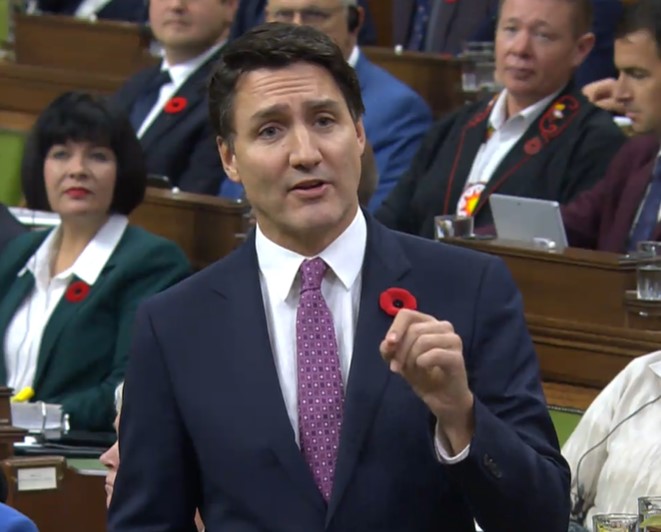Given the growth of the civil service today, the chief opposition may increasingly come from unelected public officials—’the opposition of officials.’

Prime Minister Justin Trudeau on Parliament Hill in Ottawa on November 02, 2023. (Screenshot from ParlVu)

Commentary
In Canada’s democratic political system, after a general election, the party winning the largest number of seats in the elected assembly forms the next government, and the party winning the second-largest number usually becomes “the Official Opposition.” On the surface, therefore, it might appear that the chief sources of criticism and opposition to the decisions and policies of the newly elected government will be the Official Opposition.
But with the growth of the civil service and the size of the public bureaucracies today, increasingly the chief opposition to the decisions and policies of a newly elected government may not be that of the official opposition, but that of unelected public officials—“the opposition of officials”—many of whom may remain loyal to the previous government’s priorities and policies, especially if it has been long in office.
How to gain effective control over the civil service and overcome this opposition of officials thus becomes one of the first and most important tasks of a newly elected government, regardless of party, if government is to be primarily directed by those elected by the voters.
Canada’s federal bureaucracy, including Crown corporations, agencies, and contract employees, now includes over 350,000 people. If the next federal election were to produce a new government—with say 180-plus seats in the 338 seat House of Commons and a cabinet of 35 ministers headed by the prime minister—this relatively small group accountable to Canadians will need to overcome whatever “opposition of officials” exists and gain control of the federal bureaucracy in order to implement the commitments it made to electors during the election. A formidable task indeed!
To use a western analogy, winning an election today can be like winning the opportunity to ride the bull at the Calgary Stampede. The bull is much larger and more powerful than the rider, and if unfriendly, is quite capable of unseating the rider.
Time and space does not here permit a full discussion of ways and means of overcoming the opposition of officials and gaining democratic control over huge public bureaucracies, but here are a few key suggestions to prompt the discussion—a discussion which the leadership, candidates, members, and advisers of any political party aspiring to form government needs to have prior to, not after, winning election.
1. Identify the Professionals
Within any huge public bureaucracy there will be numerous individuals of limited competence just “doing a job” with no conception of or commitment to rendering genuine public service. And there will be political hacks who owe their positions solely to their partisan connections. But there will also be genuinely professional civil servants who bring professional expertise, experience, and commitment to their jobs and are prepared to work conscientiously with and for whomever the electorate chooses to form government. These need to be identified by a new government, preferably in advance of its election.
2. Identify Potential Allies
When an existing government is on its way out as a result of incompetence, policy failures, ethical lapses, or for whatever reasons the public sees fit to discharge it, there will be members of the civil service who share those reasons and will be more than happy to see the old government replaced. For example, there are presently senior civil servants in Canada’s Finance Department who are as concerned about the out-of-control spending of the Trudeau government as are Canadian taxpayers. There are key civil servants in the Foreign Affairs Department who consider the current foreign affairs minister to be a disaster and long for a competent replacement. And there are conscientious officials in the Justice Department who are tired of having to endure and even defend unethical behaviour on the part of others, including the prime minister. All of these are potential allies of a new government, but again they need to be identified, preferably in advance of the election.
3. Identify Who Needs to Go
Lastly and regrettably, there will be the unprofessional members of the civil service, those who are demonstrably incompetent or redundant, those who owe their positions solely to partisan patronage, and those who will be ideologically opposed to the policies of the new government and determined to frustrate it if they remain in their positions. These to need to be identified, again, preferably in advance of the election.
At the upper levels of a public bureaucracy, the greatest opposition to reducing its size will come from those who actually believe that some action or expenditure by government and its employees is always the answer to every public problem—the bigger the government, the better. And at the middle and lower levels, the opposition to any downsizing will likely come from the public service unions whose strength is in numbers. The “change of government” plan therefore needs to include alignment incentives for those willing to realign themselves in accordance with the priorities and positions of the new government, and appropriate severance and early retirement packages for those who must be fairly and effectively discharged as soon as the new government is in place.
Identifying genuine professionals within the public bureaucracy, potential allies, and “those who must go” if a newly elected government is to gain the control needed to achieve real change, becomes one of the most important pre-election tasks of the party next in line to form that new government. In Canada, that party is Pierre Poilievre’s Conservative Party of Canada.